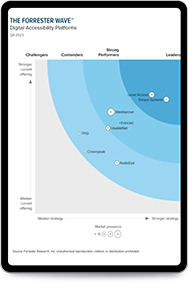W3C
Feb 13, 2024
The World Wide Web Consortium (W3C) is an international stakeholder community that establishes globally recognized web standards. These include, but aren’t limited to, standards for web accessibility, internalization, usage, privacy, and security. It is made up of member organizations, a full-time staff, and the general public. The W3C’s goal is to develop a set of open web standards.
The W3C was formed in 1994, just five years after the introduction of the first World Wide Web server. With individuals and organizations flocking to new online spaces, it was imperative that a set of web standards be put into place to help guide website creation. As of January 2023, the W3C is classified as a public-interest 501(c)(3) non-profit organization.
What does the W3C do?
Primarily, the W3C creates standards that are designed to ensure the long-term growth of the Internet. These standards define the critical elements of making the World Wide Web work for everyone, including people with disabilities. As a socially responsible organization, the W3C involves stakeholders around the globe, and members determine web standards by reaching a consensus. The W3C’s web standards are royalty-free, meaning that they can be used at no cost.
The W3C also publishes documentation, along with educational and informational materials, to support the adoption of its standards.
Did the W3C invent WCAG?
The Web Content Accessibility Guidelines (WCAG) are a series of web accessibility guidelines developed by the W3C. They are created in collaboration with organizations and individuals all over the world.
The first version of WCAG was published in 1999 through the W3C’s Web Accessibility Initiative (WAI). Since then, the WAI has released updated versions of WCAG every few years, to keep pace with changes in digital technology. The ongoing development of WCAG is part of the W3C’s goal of maintaining a global open standard for the web, specifically regarding digital accessibility.
What are W3C guidelines?
In addition to WCAG, the WAI’s work includes the Authoring Tool Accessibility Guidelines (ATAG) and User Agent Accessibility Guidelines (UAAG). The WAI’s Essential Components of Web Accessibility resource explains how these different sets of guidelines work together to support accessibility in web development.
Content guidelines
WCAG recommends accessibility standards for content: the information present on a given web page or web-based platform. Content covered includes, but is not limited to, text, images, and videos, as well as code, markup, and other elements that determine a site’s structure and presentation.
Authoring tool guidelines
Authoring tools refer to any software or other digital platform that “authors” (like web developers, writers, and designers) use to create online content. These include content management systems (CMS), blogs, social networks, and HTML editors. The Authoring Tool Accessibility Guidelines (ATAG) are a set of global standards for evaluating the accessibility of these tools.
User agent guidelines
The term “user agent” describes browsers, browser extensions, readers, media players, and any other software that renders web content for a user. The User Agent Accessibility Guidelines (UAAG) lay out standards for understanding whether these agents are accessible.
Other W3C standards
Beyond web accessibility, the W3C has published dozens of guidelines for web development. These include, but aren’t limited to, standards for:
- Accessible Rich Internet Applications (ARIA): ARIA, or WAI-ARIA, specifies how to increase the accessibility of web pages, particularly dynamic content and user interface (UI) components.
- Web Real-Time Communications (WebRTC): WebRTC allows individuals to communicate with each other, primarily through video meetings.
- MathML: A mathematical notation markup language, MathML aims to integrate formulas into web pages and documents natively.
- Simple Knowledge Organization System (SKOS): SKOS is a recommendation system for “controlled vocabularies,” like classification systems, subject-heading systems, and taxonomies.
Why is the W3C necessary?
Having a set of universal standards for the web that applies across search engines, web applications, and content formats helps make the web usable for the broadest possible audience. By introducing clear guidelines for the development of websites and related technology, the W3C empowers coders, content writers, and designers to make online information available to people around the world, no matter the browser or device they’re using. And by providing global standards for web accessibility, the W3C equips individuals and organizations with a framework for ensuring their digital experiences are truly accessible to everyone, including those with disabilities.
To learn more about WCAG, access The Must-Have WCAG Checklist.
